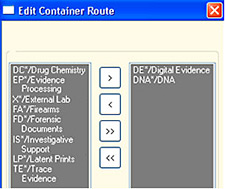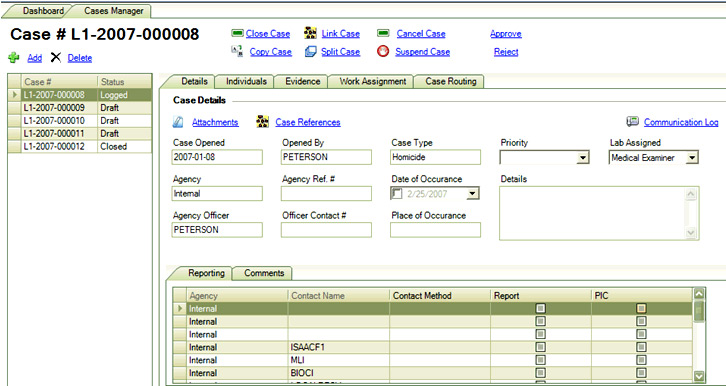Home | Glossary | Resources | Help | Contact Us | Course Map
Archival Notice
This is an archive page that is no longer being updated. It may contain outdated information and links may no longer function as originally intended.
Forensic LIMS
Initially, LIMS software was developed for research and commercial laboratories where the samples analyzed were standalone items completely unrelated to any other items under examination.
In criminal investigations, physical evidence is more often viewed collectively. This may involve multiple reports from various disciplines requiring differing timelines and sequencing of examinations.
The implementation of LIMS in forensic laboratories necessitated the development of enhanced features to accommodate the complexity of forensic analyses, specifically:
- Examination results may indicate further examinations and analyses (within same discipline or in a different discipline).
- Results may indicate additional requested examinations are unnecessary.
- Some evidence can be examined only after the arrival of additional evidence items.
Input Information
For management purposes, LIMS inputs are normally customized to the expressed or perceived needs of a given forensic laboratory.
Generally the inputs can include basic items, such as these:
- Laboratory file/case/submission number
- Date evidence received
- Submitting agency
- Submitting agency investigative file number
- Evidence listing and tracking data by item, type, and quantity
- Type(s) of examination(s) requested
- Examiner(s) assigned to an evidence submission or a particular examination
- Chain-of-custody information
- Bar coding of evidence items
- Additional examinations (in series or concurrently) required as a result of trace evidence found
- Estimated date for completion
- Date of report(s)
- Report contents
- Quality assurance information
In addition, many forensic laboratories might include customized management and administrative data such as:
- Case index reflecting the volume and complexity of the evidence submission based on a number of variables, including:
- Number of items submitted.
- Number of disciplines involved.
- Probable number of examinations required.
- Number of interrelated previous evidence submissions.
- Case prioritization system.
- Case assignment criteria to assist managers in balancing and maintaining an equitable caseload. All cases are not created equal and a single massive evidence submission can easily outweigh twenty or thirty straightforward submissions.
Some criteria to consider when assigning cases:- Examiners experience level and training versus the volume and complexity of a new evidence submission
- Each examiners areas of qualification
- Priority assigned to a new case
- Previous submissions in the same or related cases
Output Information
First and foremost, the management and analysis of the current caseload and case production is the responsibility of the section supervisor. The LIMS is simply a tool to assist in this process.
LIMS goals:
- Immediately assess the status and progress of a given evidence submission.
- Produce a quick snapshot of the overall current caseload at any time.
Information examples may include
- types and numbers of current cases,
- cases completed on a weekly, monthly, or year-to-date basis,
- number and type of examinations completed,
- cases not meeting agency guidelines by unit or by examiner,
- current status and cumulative statistics for each area by subdiscipline,
- current status and cumulative statistics by individual examiner.
System Developments
Some ongoing developments becoming more widely adopted in forensic LIMS systems include
- preformatted laboratory notes and reports,
- digital imaging, video, and audio clips,
- systems that prompt the user to check for possible additional comparisons.
These features may assist the examiner, but should not become a substitute for critical thinking.
Additional Online Courses
- What Every First Responding Officer Should Know About DNA Evidence
- Collecting DNA Evidence at Property Crime Scenes
- DNA – A Prosecutor’s Practice Notebook
- Crime Scene and DNA Basics
- Laboratory Safety Programs
- DNA Amplification
- Population Genetics and Statistics
- Non-STR DNA Markers: SNPs, Y-STRs, LCN and mtDNA
- Firearms Examiner Training
- Forensic DNA Education for Law Enforcement Decisionmakers
- What Every Investigator and Evidence Technician Should Know About DNA Evidence
- Principles of Forensic DNA for Officers of the Court
- Law 101: Legal Guide for the Forensic Expert
- Laboratory Orientation and Testing of Body Fluids and Tissues
- DNA Extraction and Quantitation
- STR Data Analysis and Interpretation
- Communication Skills, Report Writing, and Courtroom Testimony
- Español for Law Enforcement
- Amplified DNA Product Separation for Forensic Analysts



